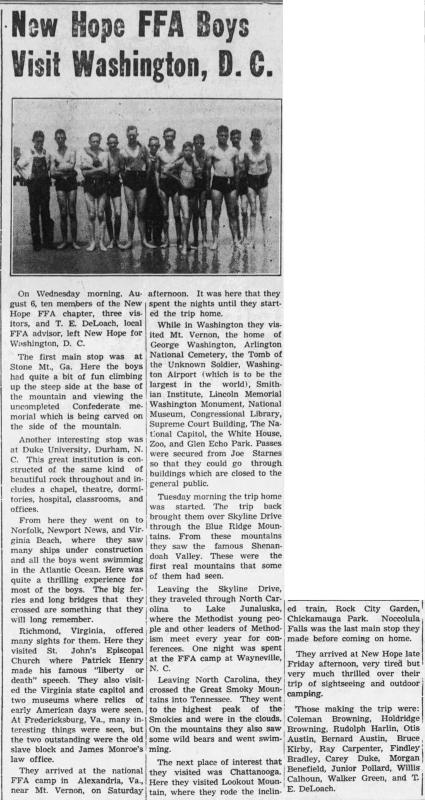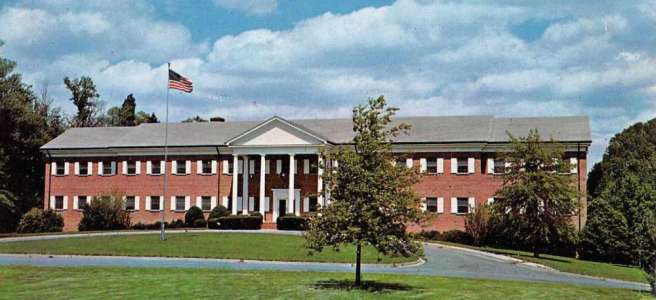In last week’s Footnote we learned about the camping trips many FFA chapters went on in the early years of the FFA. Even though Yellowstone National Park was a favorite destination, numerous FFA chapters wanted to visit Washington, DC to see the Capital and learn about our government. However, where does one camp in the DC area?
The national FFA Executive Secretary A. W. Tenney (1977, p. 146) wrote:
The nation’s capital gradually became the mecca for these travel groups. They frequently did not make reservations for housing and would call their Congressman for assistance in finding a place to camp after they arrived in Washington, D.C. The Congressman would call the National FFA Office and ask for help in finding a place for 25 to 100 members to sleep. Such problems helped increase interest in the development of a camp and center for the FFA in the Washington, D.C. area.
The situation described by Tenney led the FFA to establish a National FFA Camp conveniently located near Washington. In this Footnote we will learn more about the National FFA Camp and why it no longer exists.
In 1956 John Farrar, Director of Public Relations for the National FFA authored a booklet, FFA at 25, which detailed the history of the FFA up until that point in time. A. W. Tenney, national FFA Executive Secretary updated the FFA history in 1977 with the publication of The FFA at 50. Most, but not all, of what follows comes directly from the FFA at 25 or The FFA at 50. (I hope someone in the FFA is starting to work on The FFA at 100. That anniversary will be here before we know it.)
In the Beginning
As early as 1934 there had been discussion of a national leadership training school for FFA members. Some wanted to hold a school in conjunction with the national convention. Others wanted it held at a time and place separate from the convention.
State FFA camps were gaining wide popularity at the time and were used, in many cases, for leadership training as well as for recreational activities. It was natural that consideration be given to establishing a national FFA camp.
Delegates to the 1937 convention adopted a motion designating the Board of Trustees as a committee to determine the advisability of establishing a national FFA camp and leadership training school in Washington, D. C.
Efforts to locate a good camp site during the next year were not successful, but the plan of developing such a camp was approved, and the 1938 convention delegates voted to set aside $6,000 to start the camp.
At the 1939 convention Executive Secretary W. A. Ross reported that 22 ½ acres of land that once belonged to George Washington had been purchased. The site was 2 1/2 miles west of Mount Vernon near Alexandria, Virginia. A down payment of $5,000 had been made on the $8,500 purchase price. Ross reported that an additional six acres of land adjoining the property could be had for $3,500 more, and that one of Washington’s old grist mills had been restored by the Virginia Conservation Commission on property to the south of the camp.
The delegates voted $12,000 to finish paying for the land, including the additional six acres, and to start with improvement work. This was done during the next year. An old house on the property was renovated and plans were drawn for two barracks buildings and a dining-recreation hall, enough to handle 100 boys. An agreement was reached with the state of Virginia lor FFA to maintain and operate the George Washington grist mill as a sightseeing attraction (the FFA did so until they terminated the contract in 1958). E. D. Tyler, a former state FFA president in Florida, was employed as caretaker at the camp. The 1940 convention delegates voted another $10,000 for the continued development.
Rising costs forced a scaling-down of the original plans so that only one barracks building with space for 76 persons and the dining hall could be built with available funds.

Figure 1. The Barrick at the National FFA Camp.
This building was later used to house the FFA Supply Service.
The National FFA Camp Opens
The National FFA Camp officially opened for business June 1, 1941. However, on May 30, 1941, a group of FFA members from Wilton, Wisconsin were the first to make use of the camp facilities. During the remainder of the summer, 483 boys from 49 chapters in 17 States used the camp as a place to stay while they toured in the Washington vicinity.
While the Wilton FFA might have been the first to use the camp, an FFA Chapter from Opelika, Alabama thought they were the first as mentioned in the newspaper article below. This article was published on June 10, 1941, 10 days after the camp opened for business.

Figure 2. From the Bristol (TN) Herald Courier, June 10, 1041.
What was it like to be at the National FFA Camp? What did the campers see when they toured Washington, DC? We have some idea from a newspaper article about the New Hope, Alabama FFA Chapter’s trip to Washington in 1941 (See Figure 3).

Figure 3. From The Roanoke Leader (AL), September 17, 1941.
While most newspaper reports tend to focus on the facts, the report that appeared in the Opelika Daily News (AL) in 1949 went beyond the dry facts about the trip to Washington. It was probably written by the chapter reporter. It will bring a smile to your face (See Figure 4).

Figure 4. From the Opelika (AL) Daily News, August 4, 1949.
The Demise of the National FFA Camp
The outbreak of World War II in the fall of 1941 left the FFA with a good-sized white elephant on its hands. Both the camp and the grist mill were closed until the summer of 1946. Travel restrictions during WWII prevented FFA chapters from traveling to Washington and the distance from the capital (relatively close by today’s standards) was also a drawback.
During World War II tomatoes were grown on the property to assist in the production of food. The Lead Industries Association used the camp for a painting school during the mid-1940s. This is how the buildings got painted.
In the early planning stages of the National FFA Camp, there was to be an outdoor amphitheater, a swimming pool, a recreation area, a dam, and a conference center. Those things never materialized.
Opened again after the war, the mill began paying its way from the small admission charge made to tourists, but there never were enough boys using the facilities of the national camp to make it worth the cost.
By 1949 the camp had cost the FFA about $47,600. From a cold cash standpoint, the organization would have been better off to have furnished free hotel rooms in downtown Washington to touring FFA members. Delegates to the 1949 national convention, after a thorough discussion, voted to give the Board of Trustees authorization to dispose of the camp.
In the meantime, the Future Farmers’ Supply Service headquarters had been located in one of the camp buildings. The Supply Service was expanding rapidly and housing for it would need to be located before the camp could be sold. Checking into the proposition of renting or buying facilities for the Supply Service revealed that little, if any, savings could be made by selling the camp.
By the spring of 1950 the Supply Service business had expanded to the point that all the camp buildings were required for office space and storage. The camp was closed for housing FFA tourists, but it was providing year-around service as headquarters for the Supply Service. Still later, the National Future Farmer magazine headquarters also were established at the camp.
Although the national FFA camp had been a failure for the purpose it was intended, it proved to be a reasonably sound investment. Rising real estate values in the area gave assurance that even if the property should be sold, the FFA would fare well financially.
The decision was made in the 1950s to use the land for the establishment of a National FFA Center. Ground was broken for a new building on July 24, 1956. The building was completed in 1958 and dedicated on July 24, 1959 (See Figure 5).

Figure 5. The National FFA Center was built on land in Alexandria, VA that was once the site of the National FFA Camp. It was used from 1958 to 1997.
The new FFA Center housed the Supply Service, Magazine, and other FFA-related activities. In 1968 the U.S. Commissioner of Education requested that vocational student organization employees who were employed and housed in the Office of Education be moved out of the Office of Education. The decision was made to relocate the FFA employees to the National FFA Center and have the FFA pay their salaries.
As the FFA grew, the National Center needed more room. Two additional wings were added in 1959. As the years rolled by, it was obvious the original building would require massive renovations, so a decision was made to sell the property and relocate the National FFA Center to Indianapolis. Indiana. The move was made in 1997 and the land in Alexandria, Virginia was sold shortly thereafter; thus ending a chapter in FFA history.
An interesting side note concerns the National 4-H Center located near Washington, DC. In 1959 the National 4-H Council established a 12-acre Conference Center in Chevy Chase, Maryland (the opposite side of DC from the FFA Center). The facilities were top-notch and could accommodate 800 guests. I have stayed at this facility and utilized their meeting rooms (and dining hall) numerous times with groups of graduate students from North Carolina State University who were in DC as part of their course work. Space prevents going into detail but if you are not familiar with the Center, you should follow this link https://4hcenter.org/about/ to check it out. In late March of this year (2021) a decision was made to sell the National 4-H Center. The decision was Covid driven. To learn more about that decision follow this link.
The National FFA Camp is now a memory. (and soon the National 4-H Center will also be a memory). Next week the Friday Footnote will look at state FFA Camps. Like the national FFA and 4-H, some states have sold or shut down their state FFA Camps. However, many still exist and are still going strong. Stay tuned.
